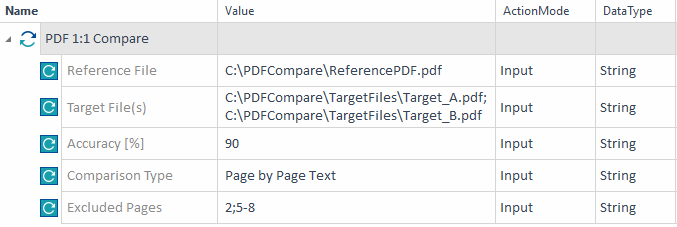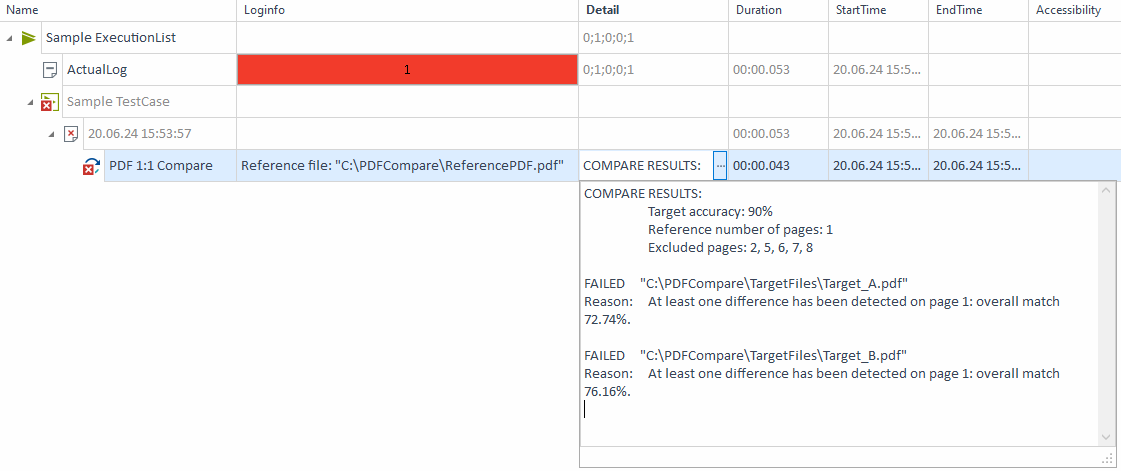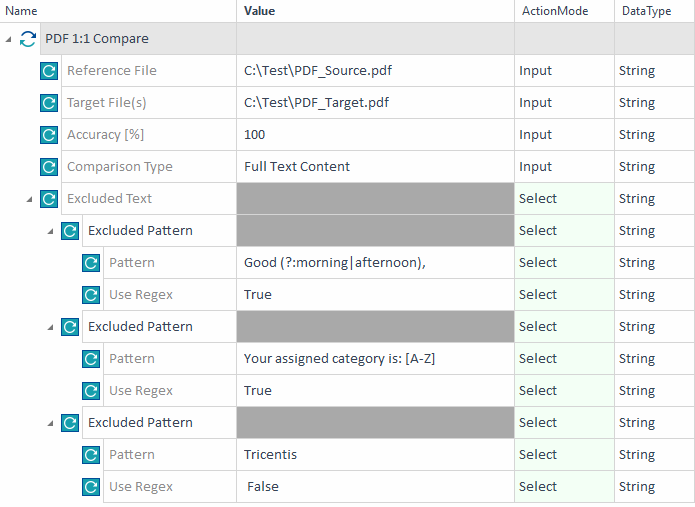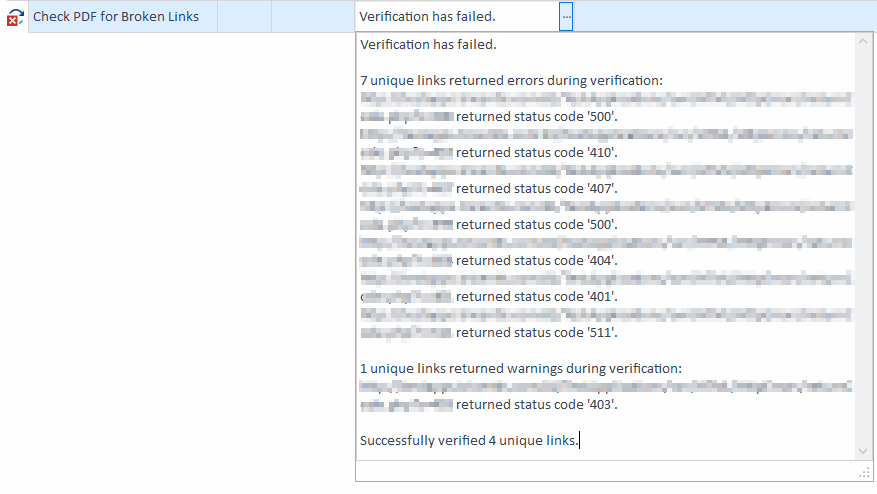PDF Modules
The folder Engines->Pdf in the Standard subset contains Modules that performs specific tasks for the PDF Engine 3.0:
PDF 1:1 Compare
The Module PDF 1:1 Compare allows you to compare two PDF files.
The PDF Engine 3.0 performs a visual comparison between the two files.
-
If the similarity between the two files is above a certain percentage, the TestCase passes.
-
If the similarity between the two files is below the expected value, the TestCase fails.
The Module has the following ModuleAttributes:
|
ModuleAttribute |
Description |
|---|---|
|
Reference File |
Full path to the first PDF file, including the file name and extension. |
|
Reference File Password |
Password to open the first PDF file. |
|
Target File(s) |
Specify which file(s) you want to compare to the Reference File. To compare the contents to a single target file, choose one of these options:
To compare the contents to multiple target files, choose one of these options:
|
|
Target File Password(s) |
Password(s) for decrypting the Target File(s). To specify multiple passwords, use a semicolon (;) as a separator. Moreover, note the following:
|
|
Accuracy [%] |
Specify the minimum similarity in percent between the two files. |
|
Comparison Type |
Specifies the type of comparison that you want to perform:
Additionally, you can tell Tosca to ignore whitespaces. To do so, use the setting Ignore whitespace in text-only comparison. |
|
Excluded Pages |
Optionally, specify the pages that you want to exclude from the comparison. To specify a page range, use a hyphen (-). To specify multiple pages or page ranges, use a semicolon (;). |
|
Excluded Areas |
Optionally, specify areas in your PDF files that you want to exclude from the comparison. The following ModuleAttributes apply for each excluded area:
|
|
Excluded Text |
Optionally, specify patterns of text that you wish to exclude from the comparison. You can use regular expressions to specify unique patterns, if needed. We recommend you use Regular Expressions 101 to verify your regular expressions. The following ModuleAttributes apply for each excluded pattern:
|

|
In this example, you compare the text contents of the file ReferencePDF.pdf with the files Target_A.pdf and Target_B.pdf. You expect that the files should be at least 90 percent similar. You exclude page 2 and pages 5 to 8 from the comparison.
Compare two PDF files The comparison result shows that the files don't have the minimum similarity that you have specified. Consequently, your TestCase fails.
Failed PDF comparison |

|
In this example, you only compare the text between two PDF files, expecting 100% similarity. Moreover, you exclude three different text patterns from the comparison:
|
Check PDF for Broken Links
The Module Check PDF for Broken Links lets you check for any links in a PDF file that return client error responses (400-499) or server error responses (500-599). This helps you verify whether there are broken links inside a document, for instance.
The Module has the following ModuleAttributes:
|
ModuleAttribute |
Description |
|---|---|
|
PDF File |
Complete path to the PDF file you want to verify. Example: C:\MyReports\YearlyReport.pdf. |
|
Ignore Errors |
Error code you want to ignore in your test. For example, enter 403 to ignore all links with a "Forbidden" response. |

|
This example TestCase investigates the PDF file located at C:\TestPDF.pdf for broken links. It checks for all error types except 403 errors.
Example - Checking for error responses Once it finds the window, it verifies all links within this web page for error responses:
Link verification example in Tricentis Tosca |
Barcode Reader
The Module Barcode Reader lets you verify or buffer the values of the following barcodes and QR codes in PDF files:
-
For barcodes: Code 39, Code 93, Code 128, EAN-8, EAN-13, UPC-A, UPC-E, ITF, Industrial 2 of 5, Inverted 2 of 5, IATA, Add 2, Add 5, Matrix 2 of 5, Datalogic 2 of 5, Codabar, BCD Matrix.
-
For QR codes: QR, Micro QR, Data Matrix, PDF417, Aztec.
The Module has the following ModuleAttributes:
|
ModuleAttribute |
Description |
|---|---|
|
PDF File |
Absolute path to the PDF file. |
|
Barcode - Type |
Specify the type of barcode you want to scan:
|
|
Barcode - Page |
Optionally, specify which pages you want to check for barcodes or QR codes. If you leave this blank, Tricentis Tosca checks all pages. |
|
Barcode - Index |
Optionally, specify the index of the barcode or QR code, to narrow down your matches. Enter one of these values:
|
|
Barcode - Value |
Specify the action you want to perform:
|

|
In this example, you verify the third QR code in a PDF document called MyPDFCodes.pdf, which is located on C: drive. The expected value is 2FH8VB6PL.
Verification example of a QR code |
Extract Links
The Module Extract Links lets you extract and buffer links inside any PDF into an array. You can then use your buffered links in later TestSteps. Tosca automatically finds all the links, so you don't need to scan the PDF.
The Module has the following ModuleAttributes:
|
ModuleAttribute |
Description |
|---|---|
|
PDF File |
Enter the full path of the PDF, including the file name and extension. |
|
Indexes |
Optionally, specify the index position of the links you want in the buffer. Index numbers start at 1. For instance, 1-3; 5 buffers the first, second, third, and fifth link. To buffer all links, leave this field blank. |
|
Links |
Enter a name for the buffer that contains the links from the PDF. |

|
In this example, you extract a link from a PDF and buffer it for use in later TestSteps.
Extract a link from a PDF |






